Hexham Abbey, England
This post follows on from yesterday's report on the town of Hexham.
Interior looking east
For persons who wish to connect with English ecclesiastic, cultural, and
architectural history then a visit to Hexham Abbey is essential. This
building is a time capsule packed with artefacts (many unique) which enables the
visitor to connect with about 1800 years of English history. Christian worship
continues here today under auspices of the Anglican Church.Hexham is 25 miles west of Newcastle upon Tyne.
The Abbey has evolved over a long period of time. Elements of the architecture/masonry date variously from the7th, 12th, 13th, 15th, 16th,19th, 20th and 21st centuries.
This building long predates the establishment of a unified English state which occurred in the 10th century AD. It is currently located in the county of Northumbria ( N.E. England) which for most of the second half of the first millennium was-or purported to be- an independent kingdom. In fact the Abbey had its origins in a substantial grant of land for endowment of a monastery made by Queen Etheldreda (of Northumbria) to Wilfred, the Bishop of York in AD 674 which led to construction of the first building.
During the second half of the first millennium what is now England became progressively occupied by immigrants from Germany, Holland and Scandinavia although it was the peoples from Frisia (Holland) who provided the basic building block for the English language.This immigration only occurred after the collapse of the western Roman Empire and Rome's withdrawal from Britain in AD 410.
During the Roman occupation (starting AD 43) only the senior military officers and civilian administrators were sourced from Rome. The native population (Britons) continued and probably spoke a form of modern-day Welsh. After the Roman departure the native populations continued in situ often resulting in clashes with the incomers.
Christianity took time get established during the early part of the first millennium with large sections of both incomers and native Britons practising paganism.As Christianity progressively took hold the Bishopric of Hexham was a major influence in the emerging power structure.There was no dividing line between church and state.
What is now called Hexham Abbey displays a long ecclesiastic history. It commenced 674-8 as a Benedictine Monastery and almost immediately became a cathedral. Following viking raids in the 9th century the site was re-founded as a Augustinian priory in the 12th century when the structure was rebuilt for a dual role as both a monastic and parish church. After the country-wide switch to Protestantism around 1540 the building served solely as the local parish church. It was again substantially restored and rebuilt in the 19th and early 20th centuries.
Readers may question rationale for the presence of pre-Christian, Roman artefacts including pagan altars and headstone type memorials.The answer is no one knows. They were taken in by the early Saxons and have remained ever since. It should be remembered that Hexham sits in a former Roman military zone which would have been littered with forts, buildings and artefacts relevant to Roman practices.
Finally, the Abbey is home to a very rare series of 15th century wood panel paintings which depict Christ's Passion. The underlying message is associated with Roman Catholicism and as such it is not understood how the panels survived the anti-catholic destruction which occurred in the 16th and 17th centuries.
Here is a video clip of the panels.
Interior looking west
Roman Altar
Roman inscription
Copy of memorial to Flavinus, a Roman officer of the 2nd century.Original stone monument is held at the Abbey.
Anglo-Saxon representation of the crucifixion
Copy of Anglo-Saxon chalice
8th century St Acca's Cross. This is carved with Christian motifs and is typical of fine Northumbrian stonework.May have been the headstone marking Bishop Acca's grave.
Sarcophagi close to exterior wall. Possibly medieval.
Exterior view of Abbey
This is the Frith stool, a Saxon cathedra or bishop's throne.
The Night Stair. Wear patterns due to devotions of generations of monks.
Creeing trough
Video clip of Abbey interior
It is hoped this post will encourage readers to visit this excellent building the development of which has closely paralleled the development of culture and religion in England.














Comments
Post a Comment